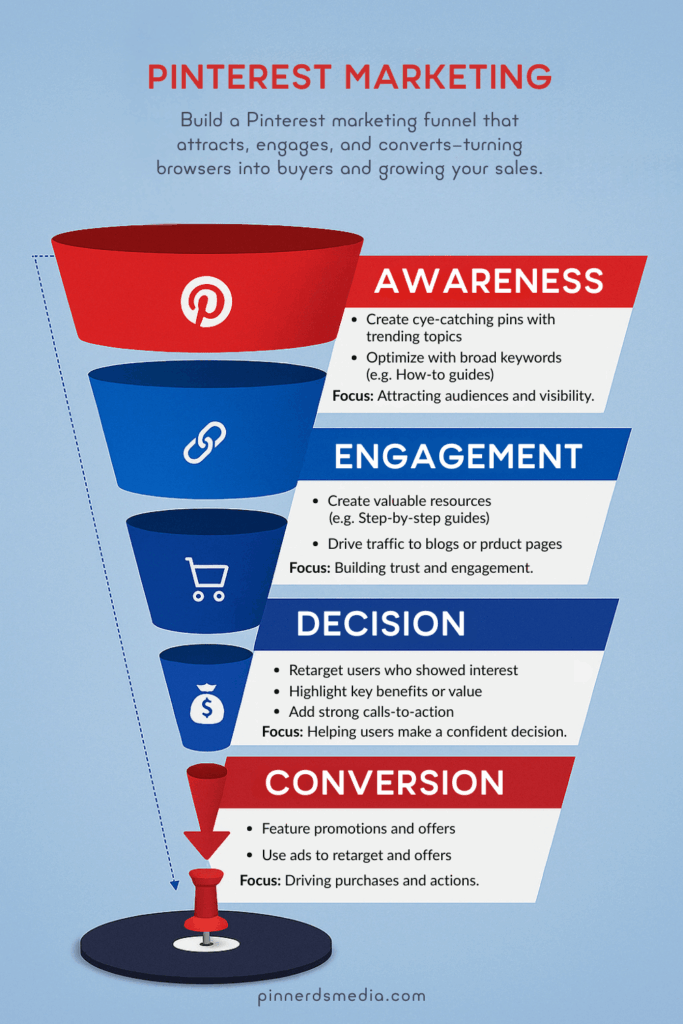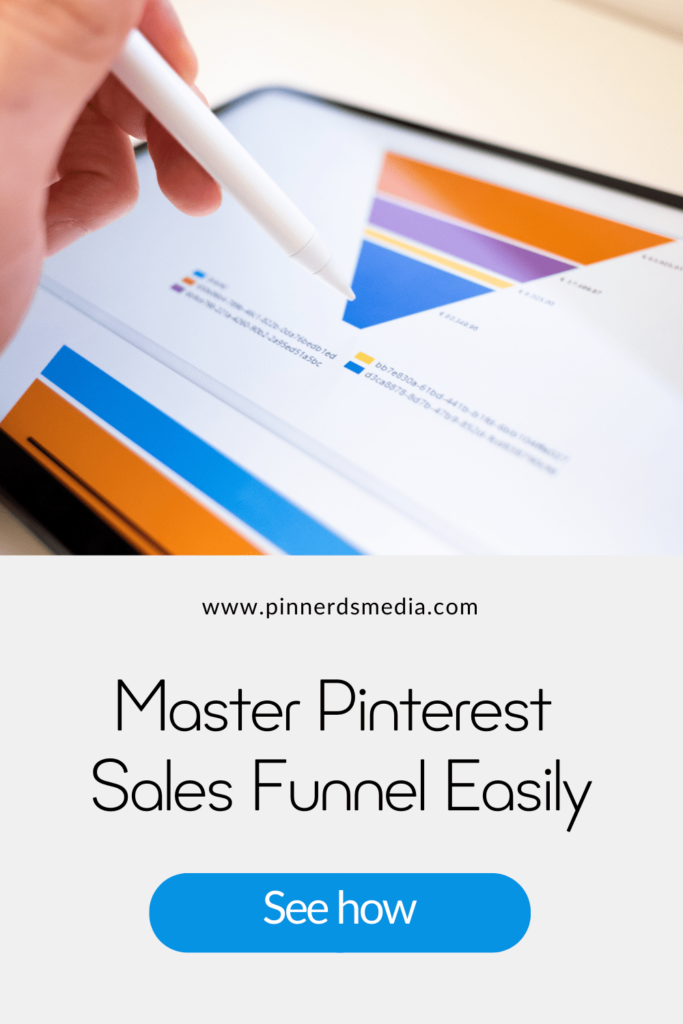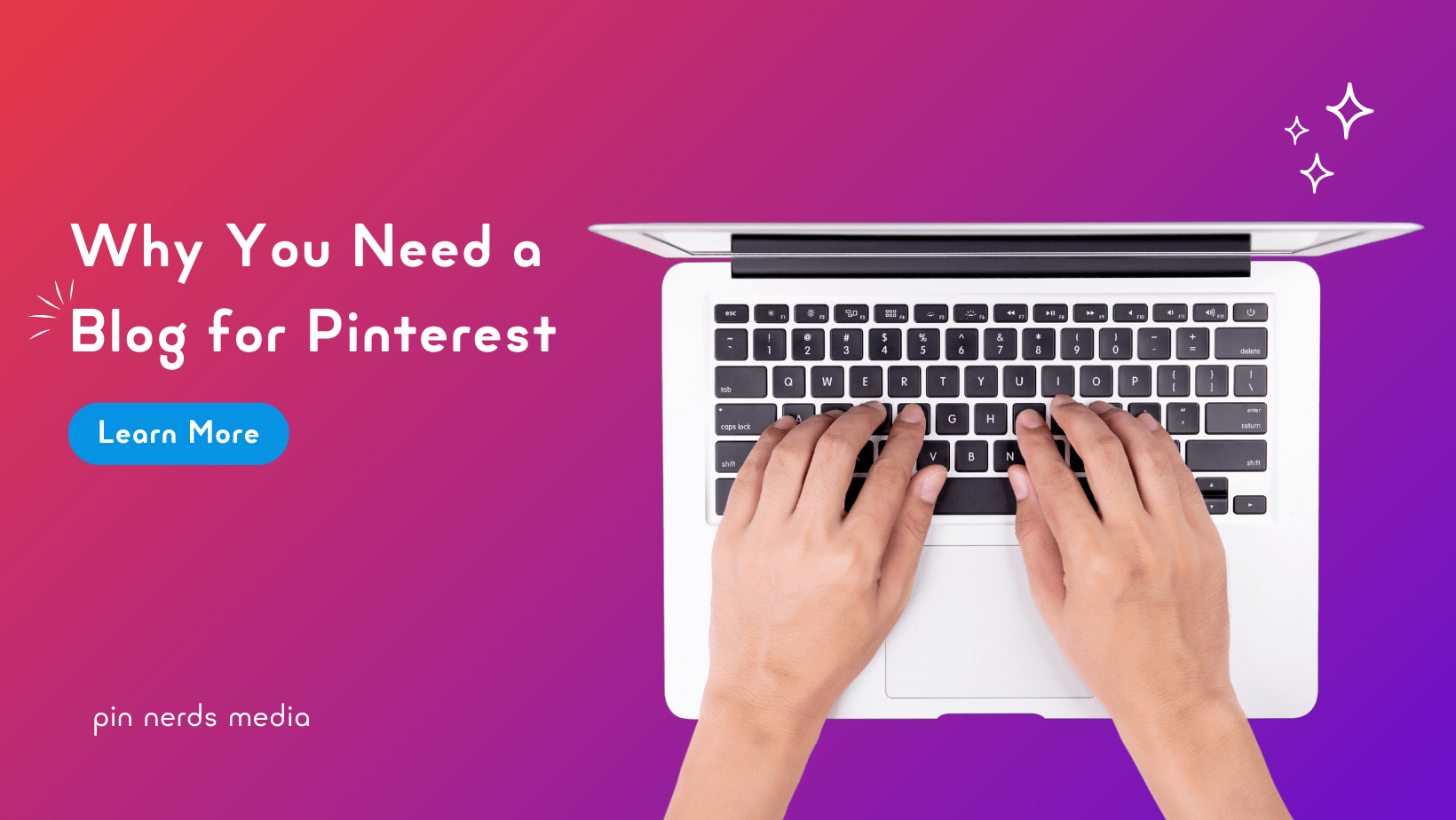This site features affiliate links that may earn us a commission at no extra cost to you if you decide to purchase through them. These commissions help us bring more valuable content to you. For more information, please see our full disclosure for more info.
How can full-funnel marketing help turn Pinterest scrollers into loyal customers? With over half a billion monthly active users, Pinterest is a goldmine for businesses.
But how can you guide users on this platform from discovery to purchase?
As a Pinterest marketing expert, I’ve seen how a well-structured funnel can improve businesses. Pinterest is more than just pretty pictures it’s a powerful platform for attracting, engaging, and converting your audience.
In this article, you will learn strategies for guiding your audience through every stage of the customer journey on Pinterest, from building awareness to boosting conversions. With 97% of top searches on Pinterest being unbranded, there’s huge potential to connect with customers and grow your business.
Learn how to make the most of Pinterest’s features, from Video Pins to Buyable Pins, and refine your strategy to increase your conversions!
Understanding the Pinterest Marketing Funnel Basics
Pinterest is a platform for marketing. It’s not just social media; it’s a visual search engine. Users actively seek inspiration and ideas here. This makes Pinterest perfect for a full-funnel marketing strategy.
What is a Marketing Funnel on Pinterest
A Pinterest funnel guides users from discovery to purchase. It’s a top-of-funnel platform, focusing on brand awareness and lead generation. Users on Pinterest are in a planning phase. It’s ideal for businesses to capture attention early in the customer journey.
Why Pinterest is Perfect for Funnel Marketing
Pinterest’s search-driven algorithm and long-lasting content make it a powerhouse for full-funnel marketing. Users here are more likely to take action, as they’re actively searching for specific ideas. This motivated buying behavior sets Pinterest apart from other platforms.
The Three Core Stages of Pinterest Marketing
The Pinterest strategy revolves around three key marketing stages:
| Stage | Focus | Actions |
|---|---|---|
| Awareness | Brand visibility | Create eye-catching pins |
| Consideration | Engagement | Provide valuable content |
| Conversion | Website visits | Optimize landing pages |
Creating a Pinterest funnel that covers each stage helps guide users from discovery to purchase, potentially tripling conversion rates compared to single-focus strategies.
Setting Up Your Pinterest Business Foundation
Starting strong on Pinterest means creating a solid base for your brand. Let’s get into the key steps to set up your Pinterest business account and make it shine.
Creating and Optimizing Your Business Account
A Pinterest business account opens doors to powerful tools and insights. Sign up for one to access analytics that help you understand your audience. Verify your account to boost credibility and reach more people.
Developing Your Brand Identity on Pinterest
Your brand identity on Pinterest should be clear and consistent. Choose colors, fonts, and imagery that match your brand’s style. This helps users recognize your pins instantly.
Remember, Pinterest provides 170% more total attention compared to other platforms, so make every visual count.
Key Profile Elements That Work
Your profile is your Pinterest storefront. Use a recognizable headshot or logo. Craft a Pinterest name that includes relevant keywords. Write a compelling bio with a clear call-to-action. Organize your boards well, aiming for 25-50 quality pins each.
| Profile Element | Optimization Tip |
|---|---|
| Profile Picture | Use high-quality brand logo or headshot |
| Username | Include relevant keywords if Pinterest provides the option |
| Bio | Clear description with call-to-action |
| Boards | Organize with 25-50 pins each |
These elements help you build a polished profile that connects with your audience and supports a strong full-funnel marketing strategy on Pinterest, a platform known for capturing 730% more passive attention than others.
Full Funnel Marketing Strategy Implementation
Using a full-funnel marketing strategy on Pinterest can really boost your ROI and sales. Brands that target customers at every stage see great results. They can see a 45% increase in ROI and a 7% rise in offline sales.
Top Funnel: Awareness Tactics
At the top, focus on making visually appealing pins that grab attention and introduce your brand. Use eye-catching images and videos to stand out. Videos are especially good, as they make up one-third of all online activity.
Share educational content, industry insights, and trendy infographics to attract potential customers. This helps draw in new people.
Middle Funnel: Consideration Approaches
In the middle, offer content that helps users decide on your offerings. Create detailed blog posts, tutorials, or product comparisons. Use lead magnets like white papers, webinars, and free templates to engage customers further.
To nurture these leads effectively, tools like Kit can automate personalized follow-up emails based on user interactions. For instance, after someone downloads a white paper or signs up for a webinar, Kit can send tailored email sequences that offer additional resources, exclusive discounts, or testimonials to keep them engaged and move them closer to making a purchase.
Remember, nearly 70% of digital shopping carts are abandoned. So, it’s key to nurture leads at this stage.
Bottom Funnel: Conversion Techniques
At the bottom, use strong calls-to-action and create pins that lead to optimized landing pages or product listings. Offer limited-time discounts, showcase customer testimonials, and provide free trials. Don’t forget about post-purchase sequences through email automation.
According to Kit, email marketing has the highest ROI of any marketing strategy, at $36 for every $1 spent.
| Funnel Stage | Key Tactics | Effectiveness |
|---|---|---|
| Awareness | Visual content, Videos | 33% of online activity |
| Consideration | Lead magnets, Tutorials | Reduces 70% cart abandonment |
| Conversion | CTAs, Email marketing | $36 ROI for every $1 spent |
At the conversion stage, your goal is to turn engaged users into customers. While organic strategies like optimized pins and strong calls-to-action are effective, incorporating Pinterest Ads can further amplify results. To get the best results from your ads, it’s important to choose the right conversion window. Let’s look through the common options available.
Learn simple ways to grow your email list on Pinterest in our guide: How to Grow Your Email List Using Pinterest. Check it out!
Common Conversion Window Options for Pinterest Ads
When running Pinterest ads, understanding the conversion window is crucial for tracking the success of your campaigns. The conversion window refers to the time frame during which actions, such as clicks or views on your ad, can be attributed to a specific conversion (e.g., a purchase, sign-up, or download). Pinterest offers flexibility in selecting a conversion window, allowing advertisers to align tracking with their sales cycles and marketing goals.
Conversion Window Options on Pinterest
- 1-Day Click or View:
- Best for fast-moving purchases or impulse buys.
- Ideal for products or offers where decisions are made quickly (e.g., flash sales or event registrations).
- 7-Day Click, 1-Day View (Default):
- Balances immediate and short-term decision-making.
- Suitable for most businesses where users need a bit of time to consider their purchase.
- 30-Day Click, 1-Day View:
- Designed for longer sales cycles or high-ticket items.
- Perfect for businesses where customers need more time to research and evaluate (e.g., furniture, vacations, or custom products).
- 60-Day Click:
- Ideal for very long consideration periods, often seen with premium products or niche industries.
- Best for businesses where customers require extended time for decision-making or involve multiple steps before converting (e.g., home renovations or professional services).
Why Choose the Right Conversion Window?
The right conversion window ensures that your Pinterest ads are accurately tracking and attributing conversions to the actions of your audience. Selecting a window that matches your customer journey helps you:
- Optimize campaigns for better performance.
- Gain accurate insights into how long users take to convert.
- Align your ad strategy with customer behavior.
For instance, a high-value product might benefit from a 60-day window to accommodate longer decision-making periods, while a seasonal promotion could rely on a 1-day window to capture immediate interest.
Want to learn more about running Pinterest ads? Check out our guide: How to Set Up Pinterest Ads for Beginners. This step-by-step tutorial will walk you through creating and optimizing ads that convert.
Creating Content That Converts
A solid Pinterest content strategy is key to driving conversions. The platform’s visual nature demands a unique approach to visual marketing. To create conversion-focused content, start by understanding your audience and their needs at each stage of the buyer’s journey.
At the top of the funnel, focus on eye-catching infographics and how-to articles. These attract attention and build brand awareness. For the middle of the funnel, showcase case studies and product demos to educate potential buyers. At the bottom, highlight customer testimonials and product features to push for conversions.
You can simplify your content creation with tools like SEOwriting.AI and ChatGPT. SEOwriting.AI enables you to generate SEO-optimized blog posts and pin descriptions in multiple languages, ensuring your content ranks well and resonates with a broad audience.
Its built-in AI image capabilities help create visually stunning pins that align perfectly with your content.
Meanwhile, ChatGPT is a great resource for generating creative ideas, unique captions, or even alternative headlines for your Pinterest pins, keeping your messaging fresh and engaging.
Remember, variety is crucial in your Pinterest content strategy. Mix up your pin formats with static images, videos, and carousels to keep your audience engaged. A smart trick is to create multiple pins from a single piece of content.
For instance, you can generate 30 unique pins from just 3 blog posts by using different headlines and designs.
Use scheduling tools like Tailwind to streamline your content strategy and ensure your pins are posted at optimal times for maximum engagement. Tailwind’s analytics can also help you identify which formats perform best, allowing you to refine your approach and maintain consistency across the funnel.
To boost your conversion rates, always include clear calls-to-action in your pin descriptions and images. This guides users toward the next step in their journey, whether it’s visiting your website, signing up for a newsletter, or making a purchase.

By consistently applying these principles and using these powerful tools, you’ll create a Pinterest content strategy that not only attracts but also converts.
Pinterest Keyword Optimization and Search Visibility
Pinterest SEO is key to making your content more visible. Optimizing your pins can greatly increase your reach. Here are some effective strategies for Pinterest SEO to make your content shine.
Keyword Research Methodology
Start your keyword research journey by using Pinterest’s search bar, which reveals related terms and trending topics. This helps you understand what users in your niche are searching for.
For more detailed strategies on mastering Pinterest keyword research, read our blog post, ‘How to Master Pinterest Keyword Research for SEO Success‘.
Strategic Keyword Placement
After finding relevant keywords, use them in your pin titles, descriptions, and board names. Since 96% of Pinterest searches are unbranded, focus on keywords that match user intent, not just your brand name.
Search-Friendly Pin Descriptions
Write detailed, keyword-rich descriptions that accurately describe your pin and entice clicks. The best pin size is 1,000px by 1,500px, or a 2:3 ratio. Longer images tend to get more clicks, so keep that in mind when creating your visuals.
| SEO Element | Best Practice | Impact |
|---|---|---|
| Keywords | Use a mix of broad and specific | Improves search relevance |
| Pin Size | 1,000px by 1,500px (2:3 ratio) | Increases engagement |
| Descriptions | Informative and keyword-rich | Boosts click-through rates |
Consistently applying these search optimization tips increases your chances of appearing in relevant searches, helping you attract more organic traffic to your content and website.
Measuring and Analyzing Funnel Performance
Tracking your Pinterest marketing funnel is key to success. Use Pinterest analytics and performance tracking tools to make smart choices. This will boost your results.
Let’s look at the important numbers to watch and how to use them for data-driven optimization.
Key Performance Indicators (KPIs)
To gauge your funnel’s health, focus on these KPIs:
| Funnel Stage | KPI | What It Tells You |
|---|---|---|
| Awareness | Impressions | How many people see your pins |
| Interest | Engagement Rate | How often viewers interact with your content |
| Desire | Click-through Rate | How many clicks your pins get |
| Action | Conversions | How many sales or sign-ups you get |
Analytics Tools and Tracking
Pinterest offers built-in analytics to track these KPIs. Use this data to understand your audience and see which pins work best.
For deeper insights, install the Pinterest Tag on your website. This tool tracks user actions, such as sign-ups, purchases, or page visits, after interacting with your pins. It provides valuable data to optimize your funnel and retarget users effectively, especially at the bottom of the funnel.
For example, you can identify high-intent visitors who abandoned their cart and re-engage them with targeted pins.
Confused about installing the Pinterest Tag? Our detailed guide can help. Still have questions? Head to the Pinterest Help Center for more info.
Optimizing Based on Data
Use your performance tracking data to fine-tune your strategy. Find your top-performing pins and make more like them. Adjust your targeting based on who engages most. With consistent data-driven optimization, you’ll see better results over time. Remember, it takes a few months to gather enough data for solid insights, so be patient and keep at it.
Final Thoughts
Pinterest full-funnel marketing is a great way to grow your digital marketing. It helps you reach more people and get better results. About 96% of website visitors aren’t ready to buy right away. This shows why a full-funnel strategy is key.
A good Pinterest marketing plan includes making fresh, eye-catching content. It also means making sure your content is easy to find and tracking how well it does. This can help your brand get noticed more, bring in more leads, and increase sales.
The path to buying isn’t always straight. People can enter the buying process at different points. So, a full-funnel strategy is essential. By keeping an eye on important metrics like website traffic and Pinterest engagement, you can improve your strategy. With time, creativity, and using data, you can make the most of Pinterest for your brand.
Was this article helpful? Save it for later! 👇



Rodney got into Pinterest marketing to help grow his wife’s cake business. In just three months, his strategies tripled their page views. Now he helps other businesses grow with Pinterest too. When he’s not working, you’ll probably find him enjoying something sweet.


